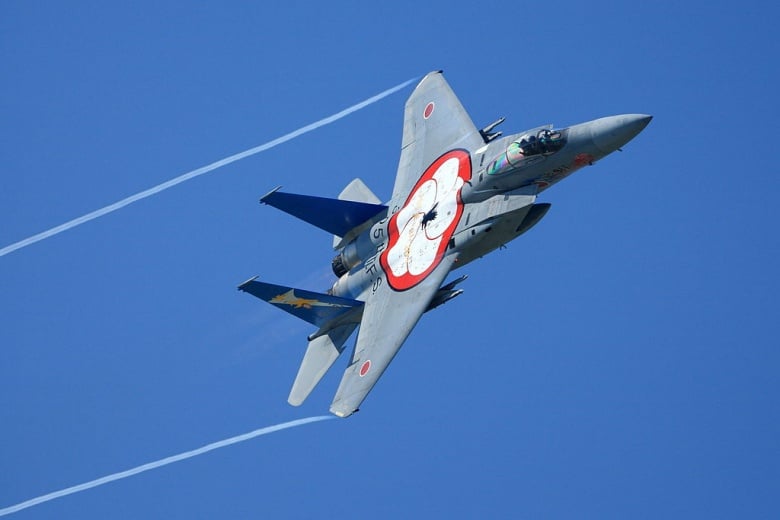A New Dawn in Japan: How China Is Empowering Its Greatest Rival

For the past seven decades, Japan hasn’t fired a single bullet for offensive military purposes, nor has it established a standing army with the mandate to engage in war. The northeast Asian powerhouse has been bound by a legendary pacifist constitution, Article 9 of which compels Japan to "forever renounce war as a sovereign right of the nation and the threat or use of force as a means of settling international disputes." Today’s Japan, unlike its imperial predecessor in the early twentieth century, is a curious case of a “rich country, no army” nation that has no parallel in modern history. But this is bound to change, as Japan reorients its foreign policy towards what it calls “proactive pacifism.”
One of the most significant implications of China’s territorial assertiveness, which has often translated into outright aggression and threat of use of force, is the empowerment of hawks in Tokyo, who have called for a more independent, capable and self-reliant Japan. Beijing’s unabashed quest for maritime dominance in the Western Pacific, with some of its top officials brazenly declaring that the South China Sea “belongs to China,” has raised alarm bells in Tokyo, which is grappling with Chinese maritime adventurism in both the East and South China Seas. For Tokyo, Beijing isn’t only aggressively staking claim to a group of largely uninhabited islets (Senkaku/Diaoyu) that Japan considers its sacred territory, but it is also undermining freedom of navigation in one of the world’s most important Sea Lines of Communications (SLOCs).
China’s brash pursuit of maritime hegemony in East Asia has inadvertently ended the decades-long strategic stupor of its archrival, Japan. Yet, far from transforming it into a militaristic nation, as China’s propaganda machine constantly declares, Japan is instead morphing into a more credible anchor of regional stability. The recent passage of a landmark security bill, which allows Japan to engage in collective security operations, paves the way for a new era of Japanese foreign policy. The northeast Asian powerhouse will no longer be confined to “checkbook diplomacy,” since it will also be able to leverage its modern armed forces to shape and preserve international order.
Man of the Hour
Under the stewardship of Prime Minister Shinzo Abe, the country has progressively recalibrated its defense policy and relaxed restrictions on Japan’s ability to project power beyond its immediate shores. Abe’s return to power, after a decisive parliamentary victory in late 2012, has coincided with an end to eleven years of budget cuts, exports of advanced military hardware (e.g., submarines) to allies such as Australia, provision of Japan’s largest postwar security aid to weaker Southeast Asian nations such as the Philippines and the revision of bilateral defense guidelines with the United States. And thanks to the recent passage of a controversial security bill, for the first time in its postwar history, Japan will be able to dispatch troops for overseas military operations under the principle of collective security.
By no means has the reorientation of Japan’s defense policy been an easy task, requiring Abe to expend much of his political capital along the way. Pacifism is deeply ingrained in the Japanese public psyche, with major opposition parties, especially the Democratic Party of Japan (DPJ), committing themselves to the preservation of Japan’s pacifist foreign policy. Imperial Japan’s brutal legacy of subjugation and colonization in Asia, and the traumatic conclusion of the Second World War that saw the usage of weapons of mass destruction against Japan’s major cities, has instilled a profound popular aversion vis-à-vis any expression of militarism and/or participation of Japan in overseas military operations.
Abe recognized the near-impossibility of garnering the two-thirds parliamentary majority support needed to push for amendment of Article 9 of the constitution, not to mention the broad public opposition that will surely sink any eventual referendum on the issue. Displaying political astuteness, he instead pushed for a reinterpretation of constitutional restrictions on Japan’s defense policy. Under the principle of collective security, Japanese leaders can authorize military forceif "the country’s existence, the lives of the people, their freedoms, and the right to seek happiness are feared to be profoundly threatened because of an armed attack on Japan or other countries.”
By adopting such broad legal language, and given the relatively open-ended nature of justifications for authorization of military force, Abe has empowered himself and his successors to dispatch the Self Defense Forces (SDF) with greater regularity and ease, specifically if it involves aiding an allied nation against a third-party aggressor. Any international conflict that affects Japan’s “right to seek happiness” or is perceived to threaten “other countries,” specifically allies such as the United States, can be used as justification to dispatch the SDF. Abe has had to use his parliamentary majority in both houses of the Japanese Diet to push through the security bill that permits collective security operations, even though, according to a poll published by Asahi Shimbun, a majority of voters (54 percent) oppose the bill, with an even greater number (68 percent) seeing no need for its expedient passage under the current parliamentary session. By sailing against public opinion, Abe has seen his approval ratings suffer a dramatic decline in recent months, now standing at only 36 percent.
Having comfortably secured his leadership position within the ruling Liberal Democratic Party (LDP), Abe is expected to remain Japan’s prime minister until 2018. This gives him ample opportunity to progressively recast the country’s foreign policy. Committed to recalibrating Japan’s postwar defense posturing, a cornerstone of his policy agenda, Abe seems unperturbed by popular opposition to his vision of a more self-reliant and capable Japan. He has displayed tremendous determination to achieve this goal, and his ruling coalition party is relishing a decisive return to power after years of perceived ineptitude under the rule of opposition DPJ party (2009-2012).
Reverse Tectonic Shift
In Tokyo, there is a genuine sense of urgency, if not panic, over the rapid shift in the balance of military power between China and Japan in the last decade and a half. In the year 2000, Japan’s defense spending was 60 percent larger than that of China. By 2012, China’s defense budget was almost three times bigger. Even in qualitative terms, China was able to rapidly close the gap. While the bulk of Japan’s defense spending went to maintenance of existing hardware, China began investing in cutting-edge technology and new acquisitions. Today, China, for instance, is the only country aside from the United States that has two fifth-generation jetfighter prototypes, the J-20 and J-31, while its burgeoning Anti-Access/Area-Denial (A2/AD) capabilities are putting it in a position to dominate adjacent waters, particularly the First Island Chain stretching from waters off the northern coast of Japan all the way to waters off the coast of Vietnam.
Dispensing with any ounce of diplomatic correctness, Japan’s latest defense White paper portrays China as a dangerous revisionist power that “has been continuing activities seen as high-handed to alter the status quo by force and has attempted to materialize its unilateral [territorial] claim without making compromises.” Japan’s Defense Minister Gen Nakatani warned that “China’s military development is of concern to the regional and international community, including our country,” reflecting how China’s behavior and military modernization has been a primary factor for Japan’s defense-policy recalibration in recent years. Despite a measure of diplomatic thaw between the two rivals, particularly since Abe’s high-profile meeting with Chinese president Xi Jinping in late 2014, Tokyo and Beijing continue to flirt with confrontation in the East China Sea, while China’s aggressive posturing in the South China Sea is undermining freedom of (military and civilian) navigation across an artery of global trade.
Over the past two years, China has reclaimed more than 1,170 hectares of land across the disputed Spratly chain of Islands, building a sprawling network of military facilities and advanced airstrips, which will allow Beijing to project power from the occupied features to the detriment of freedom of navigation and overflight in a critical SLOC and the security of Southeast Asian claimant states such as Vietnam, the Philippines and Malaysia. China’s network of military bases in the area constitute the skeleton of an Air Defense Identification Zone (ADIZ), since it will allow the Asian powerhouse, which claims the area as a “national blue soil,” to more effectively restrict the movement of vessels and aircrafts in the South China Sea. In short, China is transforming the South China Sea into a domestic lake.
Since 2012, the United States has stepped short of piercing into the 12 nautical miles radius of China’s artificially-created islands in the South China Sea, even though most of these features were originally low-tide elevations that aren’t entitled to their own territorial sea. But there are indications that the United States Navy is now preparing to extend its “freedom of navigation” operations well into the territorial sea of China’s artificially-created islands, challenging what Adm. Harry Harris, the head of Pacific Command, calls as the “great wall of sand”. As the South China Sea becomes more contested and congested, the potential for a Sino-American confrontation has become ever more likely.
In an event of a conflict between Chinese and American armed forces, Japan can provide logistical and rear-area support for the United States under the principle of collective security. With Admiral Katsutoshi Kawano, chief of the Joint Staff of the Japanese SDF, expressing his country’s willingness to partake in joint patrols in the area, Japan is poised to have a more constant and precarious military presence in the South China Sea. Japan can also indirectly support its chief Southeast Asian strategic partner, the Philippines, if the latter is involved in a military confrontation with China. Under the 1951 Mutual Defense Treaty, the United States is obliged to come to the Philippines’ rescue if the troops and vessels of its Southeast Asian ally come under attack within the Pacific theatre. This means, any Chinese armed conflict with the Philippines could involve the United States as well as Japan, which, under the principle of collective security, can provide auxiliary support. No wonder then, top Filipino officials openly welcomed the recent passage of Japan’s security bill.
As Japan (once again) assumes a pivotal role in preserving regional security, it has become more important than ever for the Abe administration to unequivocally dispel any fears over a remilitarization of Japan and push back against any expression of historical revisionism among his political allies. This is why Abe’s apology statement in August -- which admitted that Imperial Japan "took the wrong course and advanced along the road to war", used terms such as "deep remorse" (tsusetsu na hansei) and "apology" (owabi), and called Japanese people across generations to “squarely face the history of the past" – represented a crucial step in normalizing Japan’s role in the region. Although a lot more is still to be desired, especially when it comes to appeasing Japan’s neighbors in Northeast Asia. But one thing is clear: China’s ostensible quest for regional hegemony has ended Japan’s strategic oblivion, paving the way for a new era in Japanese foreign policy.
Richard Javad Heydarian is an Assistant Professor in international affairs and political science at De La Salle University, and previously served as a policy advisor at the Philippine House of Representatives. As a specialist on Asian geopolitics and economic affairs, he has written for or interviewedbyAl Jazeera, Asia Times, BBC, Bloomberg, Foreign Affairs, The New York Times, Wall Street Journal, The Huffington Post, The Diplomat, The Financial Times, and USA TODAY, among other leading international publications. He is the author of How Capitalism Failed the Arab World: The Economic Roots and Precarious Future of the Middle East Uprisings (Zed, London), and the forthcoming book Asia’s New Battlefield: US, China, and the Struggle for Western Pacific (Zed, 2015). You can follow him on Twitter: @Richeydarian.
Image: Wikimedia Commons/Cp9asngf






No comments:
Post a Comment